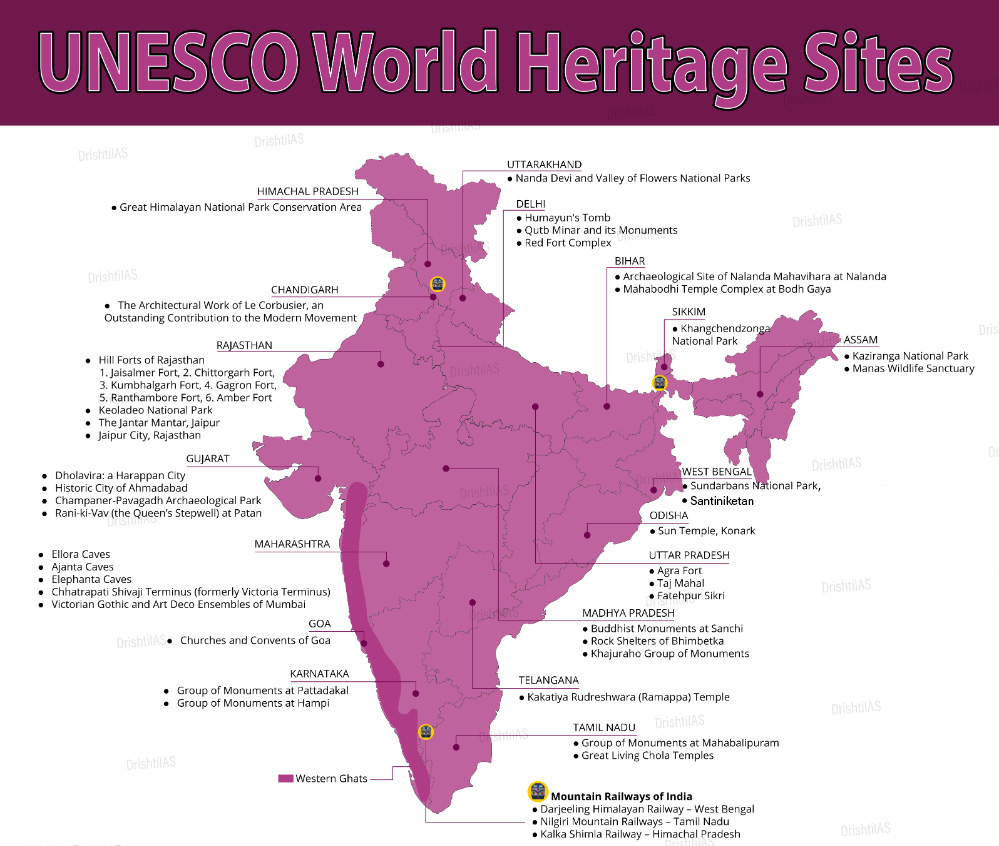Santiniketan Becomes India's 41st World Heritage Site | 18 Sep 2023
For Prelims: Santiniketan, UNESCO’s World Heritage List,Rabindranath Tagore, Debendranath Tagore, Visva Bharati University, Archaeological Survey of India (ASI).
For Mains: Importance of declaration of Santiniketan as UNESCO world heritage sites.
Why In News?
Recently, Santiniketan, which is a town located in Birbhum district of West Bengal, was included in the UNESCO’s World Heritage List.
- The efforts to have Santiniketan recognized as a UNESCO World Heritage Site have been ongoing since 2010. Santiniketan has been recognized by UNESCO as India's 41st World Heritage Site.
Why is Santiniketan Well Known?
- Historical Significance: In 1862, Rabindranath Tagore's father, Debendranath Tagore, spotted this scenic landscape and decided to establish an ashram, building a house called Santiniketan, meaning "abode of peace".
- Name Change: The area, originally called Bhubadanga, was renamed Santiniketan by Debendranath Tagore due to its conducive environment for meditation.
- Educational Legacy: In 1901, Rabindranath Tagore chose a significant portion of land and established a school based on the Brahmachary Ashram model. This school later evolved into Visva Bharati University.
- UNESCO World Heritage Site: The Ministry of Culture proposed Santiniketan for inclusion in the UNESCO World Heritage List, emphasising its importance in human values, architecture, arts, town planning, and landscape design.
- Archaeological Preservation: The Archaeological Survey of India (ASI) has been involved in the restoration of several structures in Santiniketan, preserving its historical and cultural heritage.
Who was Rabindranath Tagore?
- Early Life:
- Rabindranath Tagore was born on May 7, 1861, in Calcutta, India, into a prominent Bengali family. He was the youngest of thirteen children.
- Tagore was a polymath and excelled in various fields. He was not only a poet but also a philosopher, musician, playwright, painter, educator, and social reformer.
- Nobel Laureate:
- In 1913, Rabindranath Tagore became the first Asian to be awarded the Nobel Prize in Literature for his collection of poems titled "Gitanjali" (Song Offerings).
- Knighthood:
- Rabindranath Tagore was awarded with Knighthood for Services to Literature by King George V in 1915.
- Tagore renounced his title of Knighthood after the 1919 Jallianwala Bagh Massacre.
- Composer of National Anthems:
- He wrote the national anthems of two countries, "Jana Gana Mana" (the Indian national anthem) and "Amar Shonar Bangla" (the Bangladesh national anthem).
- Literary Works:
- His literary works include poems, short stories, novels, essays, and plays. Some of his notable works include "The Home and the World," "Gora," Gitanjali, Ghare-Baire, Gora, Manasi, Balaka, Sonar Tori, and "Kabuliwala."
- He is also remembered for his song ‘Ekla Chalo Re’.
- Social Reformer:
- He was an advocate for social reform, promoting ideas of unity, harmony, and tolerance. He criticised British colonial rule and worked for Indian independence.
- Tagore's Philosophy:
- His philosophy emphasised the importance of humanism, spirituality, and the connection between nature and humanity.
- Literary Style:
- Tagore's writing style was marked by its lyrical and philosophical qualities, often exploring themes of love, nature, and spirituality.
- Death:
- He passed away on August 7, 1941, leaving behind a rich legacy of literature and a lasting impact on Indian and world culture.
What are UNESCO’s World Heritage Sites?
- A World Heritage Site is a place that is listed by UNESCO for its special cultural or physical significance.
- The list of World Heritage Sites is maintained by the international 'World Heritage Programme', administered by the UNESCO World Heritage Committee.
- This is embodied in an international treaty called the Convention concerning the Protection of the World Cultural and Natural Heritage, adopted by UNESCO in 1972.
UPSC Civil Services Examination, Previous Year Question (PYQ)
Prelims:
Q. Which one of the following National Parks has a climate that varies from tropical to subtropical, temperate and arctic? (2015)
(a) Khangchendzonga National Park
(b) Nandadevi National Park
(c) Neora Valley National Park
(d) Namdapha National Park
Ans: (d)
Mains:
Q. What was the difference between Mahatma Gandhi and Rabindranath Tagore in their approach towards education and nationalism?(2023)

